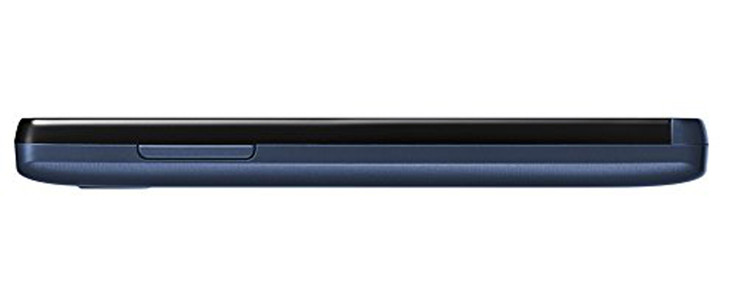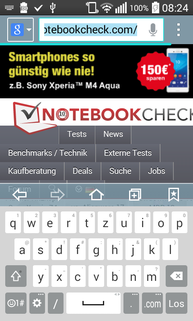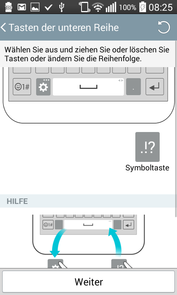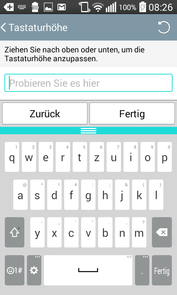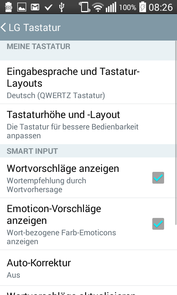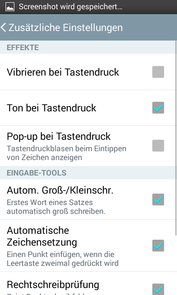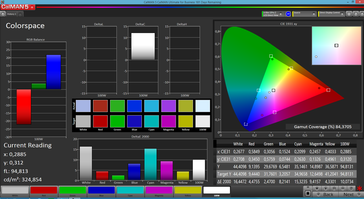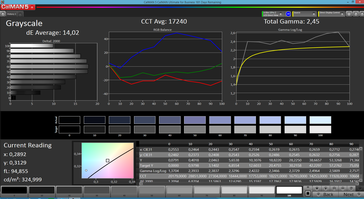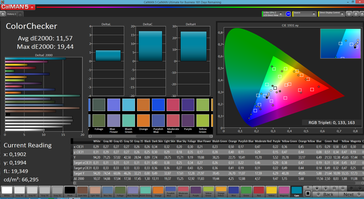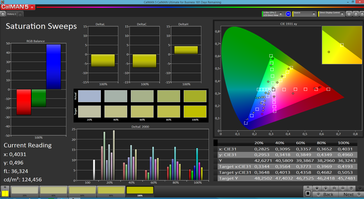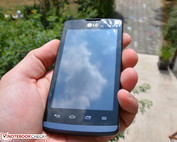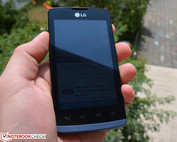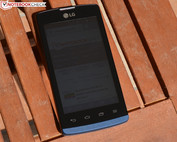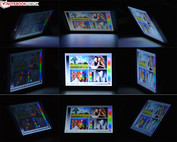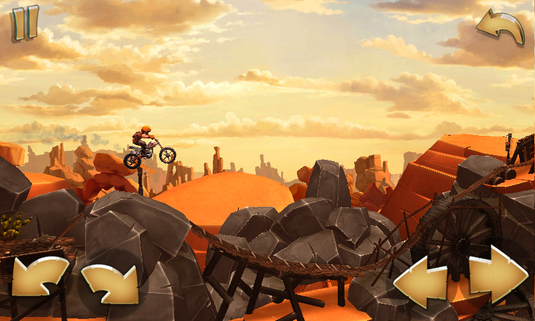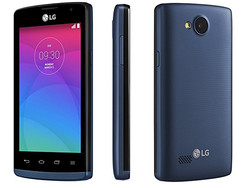LG Joy Smartphone Review
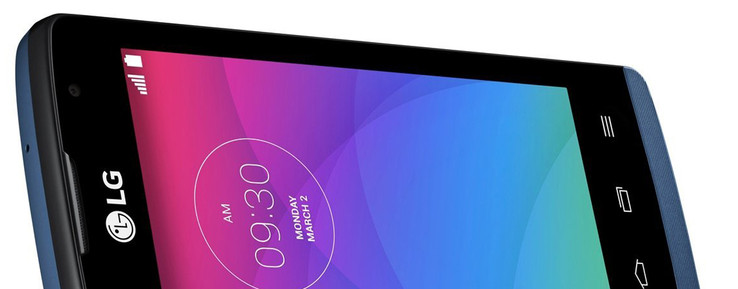
For the original German review, see here.
LG's Joy is sold at an RRP of 100 Euros (~$111), which makes it the cheapest available smartphone of the South Korean manufacturer's entry-level sector. The modest configuration also makes that evident. A 4-inch TFT screen with a resolution of 800x400 pixels, a Qualcomm Snapdragon 200 MSM8210 dual-core SoC clocked at 1.2 GHz, low 512 MB of RAM and a tiny 4 GB flash memory are on board. The latter can be expanded via a micro-SD card. Wi-Fi b/g/n and UMTS are installed, and Android 4.4.2 KitKat is the operating system. The battery is removable.
We used the Huawei Y540, Microsoft Lumia 532, Samsung Galaxy J1, as well as the slightly more expensive Sony Xperia E4g for the direct comparison.
Case
The review sample is made completely of plastic that features a plain design. Its rigidness corresponds to the price range, but light pressure on the screen is enough to cause color distortions. Furthermore, our warping attempts provoked an audible creaking and cracking noise. The build, with evenly spaced gaps, is otherwise good.
The back cover can be removed, but there is unfortunately no recess, making it necessary to lever it open via the micro-USB 2.0 opening. In addition to the removable battery, slots for a micro-SIM and micro-SD card are under the back cover that has been rippled and rounded for a better feel. Besides our blue-black review sample, LG's Joy is also to be available in white-black, but this combination is yet to be found in online shops.
Although the device's dimensions of 122.7 x 64 mm makes it the most compact phone in the comparison field, it is taller than its rivals with a height of 11.9 mm.
Connectivity
LG's Joy provides the essential interfaces with micro-USB 2.0 and a 3.5 mm audio jack. The former is easy to reach on the smartphone's lower edge and can connect to a computer via LG PC Suite. MHL, Miracast, DLNA and USB OTG are not supported. In return, Wi-Fi Direct for transmitting without a local Wi-Fi access point is available.
One major drawback of LG's Joy is its internal storage of 4 GB. Only a scanty 1.34 GB net can be used, which makes a storage expansion via micro-SD (32 GB according to manufacturer, 64 GB possible in the test) a must. Unfortunately, not all apps can be moved to the memory card using App2SD. Nor is it possible to set the card as the primary storage location, making it impossible to download very large apps. A headset, which is not included, is needed as an antenna for the FM radio.
Software
The dated Android 4.4.2 KitKat operating system is used in LG's Joy. It, however, runs quite smoothly in conjunction with LG's proprietary Easy UI desktop. It facilitates handling larger fonts and icons, among other things. The pre-loaded apps are kept within limits; besides the familiar Google pack, some useful apps like LG Smart Keyboard, Knock Code, QuickMemo, LG Smart World and Polaris Office are installed.
Communication & GPS
Calls can be made via quad-band GSM and Dual-band UMTS. As common in this price range, there is no LTE or dual-band Wi-Fi. The installed Wi-Fi module supports the 802.11 b/g/n standards. Its reception quality was middling at a distance of approximately 10 meters (~33 feet) from the router and through three walls.
The GPS module is relatively quick and reliable. Outdoor tracking was accomplished in about half a second with an accuracy of 7 meters (~23 feet) using the GPS Test app. Finding satellites in the office took a bit longer, but then with an accuracy of 14 meters (~46 feet). The user should not trust the GPS module unconditionally though. It can, however, be used reliably for a rough localization.
Telephone & Call Quality
The phone app corresponds to the standard Android application, and provides all essential features like call lists, groups and favorites. The call quality is satisfactory, which our contact also confirmed. A muffled sound and occasional annoying side noises were noticed on the review sample's side. The overall quality is still decent.
Cameras & Multimedia
An interesting detail first: The Joy still had a front-facing camera at LG's product presentation in early 2015, and an LED flash was flange-mounted beside the primary camera. However, LG has opted against that, likely for cost reasons, and LG's Joy now only features a rear-facing camera with a resolution of 5 megapixels (2560x1920 pixels). Videos can only be recorded in WVGA with 800x480 pixels. In addition to a timer and touch & shoot, voice release is also possible. It only responds to loud commands, especially when taking selfies, and generally responds a bit slow. The lens' image quality is middling, and the achieved sharpness is unsatisfactory. Furthermore, objects are slightly overexposed, and colors thus look a bit inaccurate. As expected, the low light performance is abysmal and produces low-detail, faded pictures.
Accessories
LG includes a charger, USB cable and quick start guide for the Joy besides the device itself and its battery. Optional accessories, such as various headsets, external or replacement batteries, are found on LG's website.
Warranty
LG specifies the usual 24-month warranty period for its Joy; the battery is covered for 6 months.
Input Devices & Handling
Using the capacitive touchscreen is relatively smooth. The accuracy is decent up into the edges. Zooming or other multi-touch gestures are identified and implemented reliably. LG's Knock Code for waking up the smartphone from standby via a personal tap pattern is also installed. Automatic screen rotation functions well, but needs a moment. The physical controls in the form of the power button and volume rocker are on the casing's sides, and have a good pressure point.
The virtual QWERTY keyboard is a bit small due to the screen's size, but it can be adjusted somewhat vertically. Furthermore, various controls can be configured singly. Identifying inputs sometimes needs a moment, which slightly thwarts fast typing. The smoothness of the screen's surface could be a bit sleeker, but is still acceptable.
Display
The small, capacitive, 4-inch TFT LC screen in the 16:10 format has a resolution of 800x400 pixels, which results in a pixel density of 233 ppi. That is on par with the comparison devices; only the slightly bigger Sony Xperia E4g has a somewhat higher resolution. Content looks sufficiently sharp despite the low resolution. The measured average brightness of 312.6 cd/m² for LG's Joy is marginally higher than Microsoft's Lumia 532, and achieves the second place in the comparison with the rivals.
| |||||||||||||||||||||||||
Brightness Distribution: 91 %
Center on Battery: 322 cd/m²
Contrast: 1039:1 (Black: 0.31 cd/m²)
ΔE ColorChecker Calman: 11.57 | ∀{0.5-29.43 Ø4.78}
ΔE Greyscale Calman: 14.02 | ∀{0.09-98 Ø5}
84.3705% sRGB (Argyll 1.6.3 3D)
Gamma: 2.45
CCT: 17420 K
| LG Joy Adreno 302, 200 8210, 4 GB Flash | Samsung Galaxy J1 Mali-400 MP2, SC8830, 4 GB Flash | Huawei Y540 Mali-400 MP, MT6572, 4 GB Flash | Microsoft Lumia 532 Adreno 302, 200 MSM8212, 8 GB eMMC Flash | Sony Xperia E4g Mali-T760 MP2, MT6732, 8 GB eMMC Flash | |
|---|---|---|---|---|---|
| Screen | -2% | -11% | -8% | 46% | |
| Brightness middle (cd/m²) | 322 | 370 15% | 484 50% | 301 -7% | 458 42% |
| Brightness (cd/m²) | 313 | 364 16% | 464 48% | 302 -4% | 434 39% |
| Brightness Distribution (%) | 91 | 95 4% | 83 -9% | 93 2% | 88 -3% |
| Black Level * (cd/m²) | 0.31 | 0.63 -103% | 0.76 -145% | 0.58 -87% | 0.21 32% |
| Contrast (:1) | 1039 | 587 -44% | 637 -39% | 519 -50% | 2181 110% |
| Colorchecker dE 2000 * | 11.57 | 5.99 48% | 11.06 4% | 6.36 45% | 6.95 40% |
| Greyscale dE 2000 * | 14.02 | 7.28 48% | 11.88 15% | 7.49 47% | 4.87 65% |
| Gamma | 2.45 90% | 2.59 85% | 2.33 94% | 2.58 85% | 2.38 92% |
| CCT | 17420 37% | 7949 82% | 12908 50% | 9135 71% | 6635 98% |
| Color Space (Percent of sRGB) (%) | 84.3705 |
* ... smaller is better
LG's Joy can clearly outrun most contenders in black level and contrast, and its rates of 0.31 cd/m² and 1039:1 are solely outperformed by Sony's Xperia E4g. The illumination of 91 percent is very homogeneous, and only Microsoft's Lumia 532 and Samsung's Galaxy J1 surpass that. Subjectively, content is reproduced with rich black and decent image sharpness.
The analysis using the CalMAN software and photospectrometer shows a shift in the red color range compared with the ideal. The color brightness could also be higher here. The grayscale levels reveal a clear bluish tint that is already visible in darker gray tones. The average color temperature of over 17000 Kelvin is much too high, which confirms the bluish tint even more. The gamma of 2.45 is close to the ideal, and the sRGB color space is still covered by approximately 84 percent.
The maximum average brightness of 322 cd/m² and intensely reflective surface slightly thwarts using the screen outdoors. However, content can still be read well in partial shade.
The viewing angles are middling as typical for TFT. Colors invert especially when looking from the smartphone's upper and lower edge; the image brightness decreases sharply when viewing from extreme angles.
Performance
LG's Joy is powered by a Qualcomm Snapdragon 200 MSM8210 dual-core SoC clocked at 1.2 GHz, which can only utilize a meager 512 MB of RAM. The nominal performance corresponds to the processors in the rivals; Microsoft's also uses the Qualcomm Snapdragon 200 MSM8210 SoC. The higher priced Sony Xperia E4g sports a considerably stronger quad-core SoC. Therefore, a greater performance difference in the synthetic benchmarks is only evident in the comparison with Sony's Xperia E4g. However, our review sample can slightly outperform its rivals in some benchmarks.
| Geekbench 3 | |
| 32 Bit Multi-Core Score (sort by value) | |
| LG Joy | |
| Samsung Galaxy J1 | |
| Huawei Y540 | |
| Sony Xperia E4g | |
| 32 Bit Single-Core Score (sort by value) | |
| LG Joy | |
| Samsung Galaxy J1 | |
| Huawei Y540 | |
| Sony Xperia E4g | |
| 3DMark | |
| 1280x720 offscreen Ice Storm Unlimited Physics (sort by value) | |
| LG Joy | |
| Huawei Y540 | |
| Sony Xperia E4g | |
| 1280x720 offscreen Ice Storm Unlimited Graphics Score (sort by value) | |
| LG Joy | |
| Huawei Y540 | |
| Sony Xperia E4g | |
| 1280x720 offscreen Ice Storm Unlimited Score (sort by value) | |
| LG Joy | |
| Huawei Y540 | |
| Sony Xperia E4g | |
| 1920x1080 Ice Storm Extreme Physics (sort by value) | |
| LG Joy | |
| Huawei Y540 | |
| Sony Xperia E4g | |
| 1920x1080 Ice Storm Extreme Graphics (sort by value) | |
| LG Joy | |
| Huawei Y540 | |
| Sony Xperia E4g | |
| 1920x1080 Ice Storm Extreme Score (sort by value) | |
| LG Joy | |
| Huawei Y540 | |
| Sony Xperia E4g | |
| 1280x720 Ice Storm Standard Physics (sort by value) | |
| LG Joy | |
| Samsung Galaxy J1 | |
| Huawei Y540 | |
| Sony Xperia E4g | |
| 1280x720 Ice Storm Standard Graphics (sort by value) | |
| LG Joy | |
| Samsung Galaxy J1 | |
| Huawei Y540 | |
| Sony Xperia E4g | |
| 1280x720 Ice Storm Standard Score (sort by value) | |
| LG Joy | |
| Samsung Galaxy J1 | |
| Huawei Y540 | |
| Sony Xperia E4g | |
| GFXBench (DX / GLBenchmark) 2.7 - T-Rex Onscreen (sort by value) | |
| LG Joy | |
| Microsoft Lumia 532 | |
| Huawei Y540 | |
| Sony Xperia E4g | |
| Smartbench 2012 | |
| Gaming Index (sort by value) | |
| LG Joy | |
| Samsung Galaxy J1 | |
| Huawei Y540 | |
| Sony Xperia E4g | |
| Productivity Index (sort by value) | |
| LG Joy | |
| Samsung Galaxy J1 | |
| Huawei Y540 | |
| Sony Xperia E4g | |
| Linpack Android / IOS | |
| Multi Thread (sort by value) | |
| LG Joy | |
| Microsoft Lumia 532 | |
| Huawei Y540 | |
| Sony Xperia E4g | |
| Single Thread (sort by value) | |
| LG Joy | |
| Microsoft Lumia 532 | |
| Huawei Y540 | |
| Sony Xperia E4g | |
| AnTuTu v5 - Total Score (sort by value) | |
| LG Joy | |
| Huawei Y540 | |
| Sony Xperia E4g | |
The pre-loaded Android browser could not completely finish the browser-based benchmark tests. For example, it always aborted the Sunspider 1.0 and Octane v2 test. Only the Kraken 1.1 benchmark could be finished successfully. LG's Joy just lags behind its rivals and can only outperform Sony's Xperia E4g. The browsing performance is thus a bit sluggish, but can be improved noticeably with Google's Chrome browser.
| Mozilla Kraken 1.1 - Total (sort by value) | |
| LG Joy | |
| Samsung Galaxy J1 | |
| Microsoft Lumia 532 | |
| Huawei Y540 | |
| Sony Xperia E4g | |
| WebXPRT 2015 - Overall (sort by value) | |
| LG Joy | |
| Samsung Galaxy J1 | |
| Huawei Y540 | |
| Sony Xperia E4g | |
* ... smaller is better
The internal storage of LG's Joy has a capacity of 4 GB, and only 1.34 GB net of that can be used. Although it can be expanded by up to 64 GB (in contrast to the manufacturer's specified 32 GB) via a micro-SD card, App2SD only functions with a few applications.
According to the Androbench benchmark test, the performance of the internal storage that is connected via the LPDDR2 controller is quite swift. Solely Samsung's Galaxy J1 operates even faster in writing small 4 KB blocks in the device comparison.
| AndroBench 3-5 | |
| Random Write 4KB (sort by value) | |
| LG Joy | |
| Huawei Y540 | |
| Samsung Galaxy J1 | |
| Random Read 4KB (sort by value) | |
| LG Joy | |
| Huawei Y540 | |
| Samsung Galaxy J1 | |
| Sequential Write 256KB (sort by value) | |
| LG Joy | |
| Huawei Y540 | |
| Samsung Galaxy J1 | |
| Sequential Read 256KB (sort by value) | |
| LG Joy | |
| Huawei Y540 | |
| Samsung Galaxy J1 | |
Games
The SoC-integrated Qualcomm Adreno 302 graphics card is in charge of video tasks. It is an entry-level member and clocks at 400 MHz. More basic games like the relatively undemanding "Angry Birds: Fight" run smoothly on it, and it even copes easily with routine multimedia tasks. The user will have to reckon with minor stutters in more sophisticated games like "Trials Frontier". Some 3D games would run on the SoC, but the little RAM capacity either slows them down or they will not run at all like in the test with "Modern Combat 5". Control via touchscreen and position sensors functioned unconditionally.
Emissions
Temperature
LG's Joy did not heat up palpably with an average idle surface temperature of approximately 31 °C (87.8 °F). The underside reached a maximum of 36 °C (96.8 °F) during full load, which is just a bit more than lukewarm. The smartphone did not get unpleasantly hot even in prolonged full load. Consequently, temperature-related throttling was not observed. The power supply also always remained within an uncritical range with a maximum of 36.4 °C (97.52 °F).
(±) The maximum temperature on the upper side is 41.2 °C / 106 F, compared to the average of 35.2 °C / 95 F, ranging from 21.9 to 247 °C for the class Smartphone.
(+) The bottom heats up to a maximum of 38.5 °C / 101 F, compared to the average of 34 °C / 93 F
(+) In idle usage, the average temperature for the upper side is 31.9 °C / 89 F, compared to the device average of 32.9 °C / 91 F.
Speaker
The rear-sided mono speaker is easily covered when holding the smartphone. It generally delivers a quite treble-heavy sound lacking adequate bass. The speaker is not suitable for listening to music or multimedia applications. Furthermore, the maximum possible volume is too low and the sound quickly tends to overdrive. The 3.5 mm jack cannot be criticized, and achieves a decent maximum volume.
Battery Runtime
We could not ascertain any feasible power consumption rates in the test with LG's Joy. The removable, 7.2 Wh (1900 mAh) battery, however, helps the review sample in achieving everyday-suitable runtimes. LG's Joy can outrun its rivals particularly in the Full HD video test run in a loop using a brightness dimmed to 150 cd/m² (60%) and disabled Wi-Fi, which is on par with Sony's Xperia E4g (2300 mAh). The review sample finished the Wi-Fi browsing test after almost six hours also using an adapted brightness. It can only outrun Microsoft's Lumia 532 (5.8 Wh, 1850 mAh) here. Both Samsung's Galaxy J1 (5.8 Wh, 1560 mAh) and Huawei's Y540 (6.4 Wh, 1730 mAh) can offer a longer runtime in this test. Adapting the brightness would make it possible to use LG's Joy for a workday of mixed use without recharging.
| LG Joy Adreno 302, 200 8210, 4 GB Flash | Samsung Galaxy J1 Mali-400 MP2, SC8830, 4 GB Flash | Microsoft Lumia 532 Adreno 302, 200 MSM8212, 8 GB eMMC Flash | Huawei Y540 Mali-400 MP, MT6572, 4 GB Flash | Sony Xperia E4g Mali-T760 MP2, MT6732, 8 GB eMMC Flash | |
|---|---|---|---|---|---|
| Battery runtime | 48% | -15% | -14% | 33% | |
| H.264 (h) | 8.8 | 8.5 -3% | 4.5 -49% | 8.8 0% | |
| WiFi v1.3 (h) | 5.9 | 10.8 83% | 5 -15% | 6.6 12% | 7.5 27% |
| Load (h) | 3.3 | 5.4 64% | 3.1 -6% | 5.7 73% |
Pros
Cons
Verdict
The minimalistic approach of the Joy reflects its low starting price. The user gets a solid smartphone that does not have any severe drawbacks, but does not have any striking feature in this price range, either. The buyer will find a 4-inch screen with sufficient brightness and decent color reproduction alongside very good black level and contrast rates for 100 Euros (~$111). The dual-core SoC has enough power for routine applications and the battery provides feasible runtimes. Furthermore, it can be doubled by exchanging the battery when required. The middling camera module is satisfactory for an occasional snapshot, but the omitted selfie lens is no longer contemporary. The communication modules do not let the user down, and even the primary function - making calls - works well thanks to the decent voice quality. The impeccable build and smooth use of Android 4.4.2 are compelling although the smartphone needs a moment to respond in some cases like screen rotation. The mono speaker's performance is disappointing, but hardly a contender does a much better job in this price range. The tiny internal storage with a net of 1.34 GB will thwart users from installing multiple, large applications. The expandability of up to 32 GB via a micro-SD is not of much use since not all apps can be moved to it. The lack of OTG, NFC or even LTE is not really a minus point in view of the price range.
Price-conscious potential buyers could give LG's solid entry-level Joy smartphone a chance since it is roughly on par with all comparison devices.
Buyers with a slightly bigger budget, who want both higher performance and a better configuration, should look closer at Sony's Xperia E4g.
LG Joy
- 08/06/2015 v4 (old)
Michael Moser















